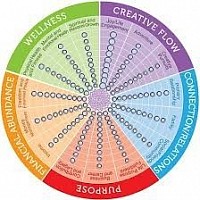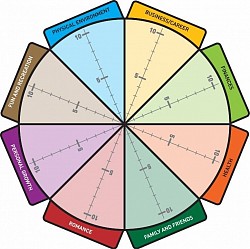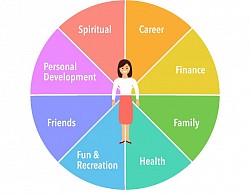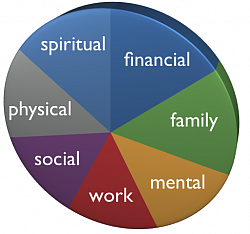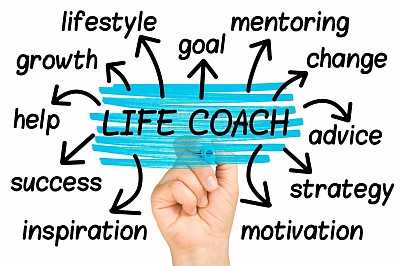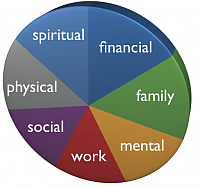Balancing Life
1. Life Balance Wheel
Unlock Your Life’s Potential with the Life Balance Wheel
One of the life coach's secret weapons is the Life Balance Wheel! This super simple, yet incredibly powerful tool helps your clients pinpoint which areas of their life are thriving and which ones need a little TLC. Whether they’re looking to level up their personal growth or create more balance in their world, this exercise gets to the heart of the matter quickly (The Coaching Tools Company, 2012).
Here’s how it works in just two steps:
Check out the 8 categories on the wheel and think about what an ideal, satisfying life would look like in each area:
Health
Friends & Family
Significant Other
Personal Growth
Fun & Leisure
Home Environment
Career
Money
Score each area: Draw a line across each segment, where the center of the wheel equals a 0 (uh-oh) and the outer edge is a 10 (you’re living your best life!). The result? A cool, spider-web-like chart that gives a quick snapshot of how your client’s life measures up to their dream life.
It’s an eye-opening exercise that can help your clients see where they’re rocking it and where they might need a little more focus.
Ready to give it a try? You can download your own copy of the Life Balance Wheel right here. And for a deeper dive into how to use it with your clients, check out this helpful article!
2. Mapping Your Influence
Getting Back on Track with Your Circles of Control
One of the biggest reasons we sometimes get stuck or feel overwhelmed on the way to our goals is because of the impact of our Circles of Control. This tool breaks down our life’s challenges into three key areas:
Things we can control
Things we can influence
Things we can’t control or influence — at least not right now
When it feels like everything is out of our hands, there’s usually still at least one thing we have direct control over: our attitude and behavior. No matter how much pressure we’re under, we always get to choose how we respond. But what else do we have control over?
We also have the power to influence certain situations. While we can’t change everything, we can guide and offer support to steer things in a better direction. For example, even though we can't control other people's attitudes or actions, we can offer advice or share resources that can help them make positive decisions.
And then there’s the final category: things we have no control over. This is the biggest area since so much of life is beyond our direct influence. A skilled life coach helps clients acknowledge and accept that, while they can’t control everything, they can focus their energy on the things they can influence and improve.
As a life coach, walking your clients through this exercise helps them identify what they can take charge of, what they can influence, and what they need to let go of. Ready to dive deeper? Click here to learn more about this tool and how it can help your clients focus on what truly matters!
3. Journaling: Your Secret Weapon for Clarity and Growth
Journaling isn’t just about writing—it’s about unlocking your inner power and creating the space for big breakthroughs. For your clients, it’s an opportunity to get real, get honest, and tap into their most authentic selves. With a little guidance, journaling can help them blaze their path to success! Here’s a fun, powerful way to make journaling count.
Unlock Your Inner Power: The Journaling Adventure
J – Judgment-Free Zone
The first rule? No judgment! Tell your clients this journal is theirs, a secret haven where they can spill their heart, write with abandon, and share what’s really on their mind. No filters, no rules—just them being them. It’s all about expressing what’s inside without worrying about anything else.
O – Observation Mode
Journaling is like hitting the “pause” button on life, giving clients the chance to observe their day as an outsider. Ask them to jot down their daily experiences and reflect on how they felt or what they learned. This “bird’s-eye view” will help them gain new perspectives, catch patterns, and discover what’s working (or not!).
U – Unlock Understanding
What happens when you pause to observe? Understanding! The more your clients reflect on their thoughts and experiences, the clearer things will become. Journaling is like a backstage pass to their mind—helping them uncover what’s driving their thoughts, behaviors, and emotions. The more they understand, the more control they gain!
R – Aha! Moments
Get ready for the "Aha!" moments! Journaling can lead to lightbulb revelations about dreams, desires, and aspirations they didn’t even know were there. When clients get in the flow of writing, they’ll tap into their deepest motivations and set a course to go after what they truly want. It’s like opening a treasure chest of possibilities!
N – Needs Uncovered
Sometimes all it takes is writing it down to make everything click. Encourage your clients to use their journal to discover what they really need—whether it’s more time for self-care, clearer boundaries, or simply a fresh perspective. Putting pen to paper can simplify even the toughest challenges, helping them find the clarity they crave.
A – Awareness Sparked
Writing helps light up the path to awareness. As your clients journal, they’ll gain a deeper understanding of their habits, challenges, and the things they’re grateful for. It’s like flipping on the light switch and seeing their life in full color! This awareness helps them take charge, make decisions, and start transforming their life for the better.
L – Life Amplified
Journaling isn’t just about reflection; it’s about feeling better. Just a few minutes of writing each day can reduce stress, calm the mind, and boost overall well-being. It’s a mini-vacation for the soul, helping clients recharge and stay centered as they navigate life’s ups and downs. Bonus: It’s fun, too!
4. Breakthrough Action Plan: The Worksheet That Sparks Results
As a new life coach, one of the most powerful tools at your disposal is the Action Brainstorming Worksheet. This easy-to-use, one-page worksheet is designed to help your clients break free from stagnation and move forward with clear, actionable steps.
The worksheet is divided into five key columns, guiding you to help your clients identify actions or behaviors they want to change or develop. Whether they're stuck in a rut or ready to take on new challenges, this tool will help them transform thoughts into real, purposeful action.
By using this worksheet with your clients, you'll empower them to prioritize and focus on the behaviors that truly matter, setting them on a path toward success. It’s a simple, effective method for you to apply right away in your coaching practice.
The Action Alignment Worksheet: Mapping Your Path to Progress
Column 1: Actions to Stop
In this first column, your client will identify the habits or behaviors they need to let go of. These are things that are hindering progress or are simply unproductive. Whether it’s a bad habit, negative thinking, or unhelpful actions, this column highlights what’s no longer serving them.
Column 2: Actions to Do Less Of
Here, your client will jot down things they’re doing that are still somewhat beneficial but may be consuming too much time or energy. It’s about recognizing activities that, while not bad, are taking up space that could be better used elsewhere. These are things like overindulging in leisure or spending excessive time on tasks that don't align with their goals.
Column 3: Actions to Keep Doing
This is where your client will highlight what’s working! These are the habits they’re already doing well and want to continue. Whether it’s sticking to a consistent routine, keeping up with healthy habits, or staying on track with their finances, these actions are aligned with their goals and they should feel proud of them.
Column 4: Actions to Do More Of
Now it’s time to dream big! In this column, your client writes down activities they want to do more of—things that are currently helping them but deserve even more attention. Whether it’s prioritizing self-care, dedicating time to a passion project, or strengthening important relationships, this section is about amplifying what’s already working.
Column 5: Actions to Start
Finally, here’s the section to think about growth! Your client will brainstorm new actions they want to add to their life. These could be anything that brings them closer to their goals—like joining a class, networking, or creating time for rest. This is where they take the leap and start something new.
The simplicity of the table ensures that it’s easy to fill out, while the structure invites your client to think deeply about their life and future. It’s a powerful tool for uncovering what’s working, what’s not, and where to put their focus. It’ll be a worksheet that clients will actually look forward to using with their coach!
5. Unleashing Your Power: Mastering Goal Clarity and Success
Unlocking Your Clients' Goals: A Powerful Tool for Clarity and Purpose
The Understanding Our Goals Worksheet is a game-changing tool that will help you guide your clients in determining whether their goals are truly worth their time, energy, and effort. This exercise will also assist you in helping them prioritize their goals based on their deeper purpose and personal value.
As a life coach, you'll guide your clients through identifying their top three current goals. The worksheet asks a series of powerful questions that encourage clients to explore why each goal matters to them and what they are really hoping to gain. By repeatedly asking, “Why do you want this goal? What does it give you?” you’ll help them peel back the layers of their motivation and truly understand their desires.
The process involves diving deep into each goal, and with every reflection, you'll help clients get closer to the heart of their aspirations. By the end, the final question for each goal will be: “What will this goal help you feel?” This exercise will help your clients uncover the core emotions they’re seeking to experience and connect with their true purpose.
Here’s an example of how this works:
Let’s say the client’s goal is to lose 20 pounds:
- The first answer might be: “To feel stronger and more energized.”
- The second round could lead to: “Achieving this will make me proud of how strong my body is.”
- The third reflection might become: “Taking pride in my body will help me feel more confident.”
- The fourth response might sound like: “Feeling confident will motivate me to take on new challenges and improve my life.”
Finally, the ultimate answer will be: “This goal will help me feel confident, healthy, and unstoppable in pursuing everything I want.”
By the time your clients complete this exercise, they’ll have a much clearer understanding of their goals—and a more powerful emotional connection to the reasons behind them. This is a great tool to help them find the motivation and drive to take meaningful action toward achieving their dreams.
6. The Power Start: Setting the Foundation for Coaching Success
This initial meeting is your opportunity to build momentum and lay the foundation for a thriving coaching relationship. It’s a chance to get aligned with your client’s goals, set clear expectations, and start crafting a powerful partnership.
- In this meeting, you’ll dive into key questions like:
- What’s going well? — Celebrate wins and successes!
- What’s not working? — Identify pain points and struggles to focus on.
Plus, this is the time to get organized:
- Create a schedule: Map out your sessions and milestones.
- Establish communication preferences: How will you keep in touch between sessions?
- Track progress: Set up a system to monitor the client’s journey toward their goals.
It’s all about setting a strong, productive tone from the start!
7. The Coaching Game Plan: Your Roadmap to Client Success
The Coaching Game Plan is your go-to tool for organizing your approach and ensuring that every coaching session is as impactful as possible. This easy-to-use worksheet will help you outline the coaching goals, brainstorm creative ways to support those goals, and track your client's progress with precision.
Here's how it works:
- Identify the Client & Goal: Clearly define who your client is and what goal they’re working toward.
- Brainstorm Support Strategies: Think outside the box to come up with actionable steps that will fuel their progress.
- Progress Tracking: Keep track of milestones and breakthroughs to see how far they've come and where they’re headed next.
- Additional Notes: Any other insights, thoughts, or breakthroughs you want to capture along the way.
This tool is perfect for coaches who want to stay organized, focused, and committed to helping their clients win. It gives you a clear picture of the coaching journey, so you can make every session count and keep your clients moving toward success!
8. The Power of Observation & Debrief Tool
The Observation & Debrief Tool is essential for coaches who observe their clients in action, especially for coach-teachers, but it’s useful for any coaching situation. It allows you to document key observations during client-led activities or classes.
After the observation, use the prompts to review next steps, ask clarifying questions, and hold a debrief discussion. This tool ensures you and your client stay aligned and focused on growth, helping you stay organized while providing impactful feedback.
Coaching Assessment Tools: Laying the Foundation for Change
As a life coach, the first step to creating meaningful change with your clients is assessing their current state. Using assessment tools is key to understanding where your clients are starting from. There are countless assessments available across various areas, so no matter what aspect of life your client is looking to improve, there’s likely a tool to help them gain clarity.
In this section, we'll explore four key areas that are vital for growth and improvement in life coaching (Stinnett, 2011):
- Leadership
- Personality
- Emotional Intelligence
- Personal Directions
While these assessments are often used in leadership coaching, they are equally powerful in the life coaching space. After all, isn’t life coaching about helping your clients take leadership of their own lives?
Leadership Assessment
Leadership is one of the most common areas where clients seek coaching. Whether it's about leading in the workplace, within a team, or even in their personal life, strong leadership skills are essential for success. As a coach, you’ll help clients assess their leadership style and identify opportunities for growth.
Here are some effective leadership assessment tools that can be used in coaching:
1. 360-Degree Feedback
- This tool collects feedback from a client's peers, subordinates, and supervisors to give a well-rounded perspective on their leadership skills. It highlights strengths and areas for improvement, offering insight from multiple sources.
- How to Use: After gathering feedback, work with your client to identify patterns and set specific goals for leadership development.
2. Leadership Styles Assessment
- This assessment helps clients understand their natural leadership style, whether they are authoritative, democratic, or laissez-faire. Knowing their leadership style can help them leverage their strengths and recognize when they need to adapt.
- How to Use: Ask your client to reflect on situations where their leadership style worked well and where it may have hindered progress. Use this insight to set action steps for improving flexibility and effectiveness.
3. StrengthsFinder
- StrengthsFinder identifies a client’s top strengths, helping them focus on areas where they naturally excel. This tool is valuable for leadership because it allows clients to build on their inherent talents rather than focusing on weaknesses.
- How to Use: Use the results to help clients align their leadership approach with their core strengths, and incorporate strategies for managing areas of growth.
4. Emotional Intelligence (EQ) Assessment
- Emotional intelligence is essential for effective leadership. This assessment measures a client’s ability to manage emotions, build relationships, and make decisions. High EQ is often linked to stronger leadership capabilities.
- How to Use: After completing the EQ assessment, work with clients to identify areas where emotional intelligence can be improved—such as self-regulation, empathy, and relationship management—and create actionable steps for development.
5. Situational Leadership Theory
- This tool helps assess how well a leader adapts their style based on the situation and the needs of their team. It encourages flexibility and teaches that different situations require different leadership approaches.
- How to Use: Work with your client to identify their current leadership style and assess whether it fits the situations they face. Use this information to create a plan for increasing their adaptability in different contexts.
By incorporating these leadership assessments into your coaching practice, you’ll be able to guide your clients to a deeper understanding of their leadership abilities and areas for growth. This not only enhances their effectiveness as leaders but also builds their confidence in leading both others and themselves.
9. Leadership Competency Self-Assessment
As a life coach, you may work with clients who want to strengthen their leadership skills — whether in their career, their community, or even their personal lives.
This Leadership Competency Self-Assessment is a tool you can use to help clients evaluate their current strengths and identify areas for growth across four key dimensions of leadership:
- Information Seeking: How actively they pursue knowledge, data, and feedback to make informed decisions.
- Conceptual Thinking: How well they connect ideas, recognize patterns, and think creatively about solutions.
- Strategic Orientation: How effectively they set goals, anticipate future trends, and align actions with long-term visions.
- Service Orientation: How committed they are to serving and supporting others, whether customers, colleagues, or their community.
Each dimension includes a set of simple reflection prompts. Clients can use these prompts to assess their strengths, identify areas for growth, and create a more intentional leadership style.
Bonus Tip:
For deeper insight, encourage clients to invite trusted colleagues, team members, or friends to provide informal feedback on how they experience the client’s leadership behaviors.
No outside resources are needed — everything you and your clients need to complete the Leadership Competency Self-Assessment is provided right here in your course materials.
Leadership Competency Self-Assessment Prompts
Information Seeking
- I actively seek out feedback to improve my performance.
- I research thoroughly before making important decisions.
- I ask clarifying questions when I don't understand something.
- I reflect on mistakes and lessons learned to guide my future actions.
Conceptual Thinking
- I can quickly spot trends and patterns in complex information.
- I enjoy brainstorming new ideas and innovative solutions.
- I often look for underlying causes rather than surface-level symptoms.
- I think ahead about possible obstacles and alternative approaches.
Strategic Orientation
- I align my daily actions with my long-term goals.
- I prioritize tasks that contribute to larger objectives.
- I anticipate future challenges and plan for them.
- I can clearly articulate my vision for success.
Service Orientation
- I look for ways to support the success of others around me.
- I am attentive to the needs of those I serve (clients, customers, community).
- I take satisfaction in helping others achieve their goals.
- I view leadership as an opportunity to serve, not just to direct.
Reflection & Action Planning
After completing the Leadership Competency Self-Assessment, guide your client through these reflection prompts:
- Which leadership dimension (Information Seeking, Conceptual Thinking, Strategic Orientation, or Service Orientation) felt the strongest for you?
- Which dimension felt like it could use the most growth right now?
- Were there any specific prompts that surprised you — either positively or as an area you hadn't considered before?
- In what ways could strengthening your leadership skills positively impact your personal or professional life?
- What is one specific action you can take this week to strengthen the leadership area you want to grow?
🎯 Optional Action Step:
Encourage your client to choose one leadership behavior to focus on over the next 30 days. Have them track small daily or weekly actions that support this growth area.
10. 30-Day Leadership Action Tracker
Instructions for Clients:
Choose one leadership behavior you want to strengthen. Each week, reflect and track your efforts. Small, consistent steps lead to real growth!
Week 1:
- Leadership Behavior Focus: _____________
- Actions I took: _____________
- Challenges I faced: _____________
- Successes and wins: _____________
- My plan for next week: _____________
Week 2:
- Leadership Behavior Focus: _____________
- Actions I took: _____________
- Challenges I faced: _____________
- Successes and wins: _____________
- My plan for next week: _____________
Week 3:
- Leadership Behavior Focus: _____________
- Actions I took: _____________
- Challenges I faced: _____________
- Successes and wins: _____________
- My plan for next week: _____________
- Week 4:
- Leadership Behavior Focus: _____________
- Actions I took: _____________
- Challenges I faced: _____________
- Successes and wins: _____________
- My plan for next week: _____________
Coach Tip:
During each coaching session, review the tracker with your client. Celebrate progress, adjust strategies, and help them stay motivated!
